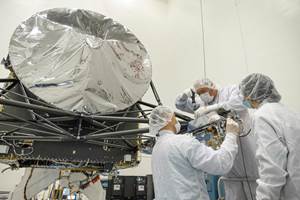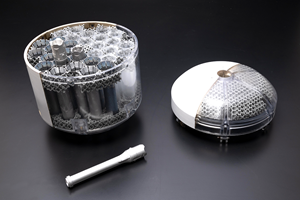Will the Successes of NASA’s RAMFIRE Project Lead to an Operational Aerospike Engine?
NASA’s RAMFIRE project has additively manufactured a 36-inch diameter aerospike nozzle with complex integral coolant channels for a more efficient way to propel rockets to outer space. NASA engineers will use this as a proof of concept to inform future component designs.
Share
Read Next
At the RPM Innovation (RPMI) facility in Rapid City, South Dakota, manufacturing for a large-scale aerospike demonstration nozzle with integral channels is underway. The laser powder directed energy deposition (LP-DED) process creates a melt pool using a laser and blows powder into the melt pool to deposit material layer by layer. NASA engineers will use the nozzle as a proof of concept to inform future component designs. Source: RPM Innovation
NASA continues to reimagine the future of rocket engine technology by accelerating the advancement of lightweight rocket nozzle production with additive manufacturing (AM). The success of NASA’s Reactive Additive Manufacturing for the Fourth Industrial Revolution (RAMFIRE) project established the viability of AM for aluminum rocket nozzles with A6061-RAM2 powder.
Now, the RAMFIRE project has used A6061-RAM2 to 3D print a 36-inch diameter aerospike nozzle with complex integral coolant channels.
For nearly seven decades, rocket engineers have considered an alternate nozzle design beyond the bell nozzle rocket engine. The aerospike design breaks free from the traditional bell nozzle rocket engine design, which is efficient at only one point in the rocket’s trajectory.
What exactly makes this nozzle so enticing, especially after the bell nozzle has more than proven its capabilities throughout the history of human spaceflight?
The Aerospike’s inside-out rocket nozzle plume travels externally, rather than exiting inside of the traditional bell-shaped nozzle. The main advantage of the aerospike nozzle is that, as the rocket climbs, atmospheric and airstream pressure act on the plume to keep it at an optimum setting along the entire trajectory. This enables a very efficient engine performance in flight, capable of delivering higher payloads while decreasing overall rocket weight and improved performance over a range of pressure altitudes.
So, if the aerospike nozzle design is considered a more efficient way to propel rockets to outer space, why has it never been seriously tested on the launchpad?
The lack of actual flight test data has precluded use of these nozzles in current as well as next-generation space launch vehicles. In addition, the configuration of an aerospike nozzle presents unique challenges to the designer and fabricator.
The mindset of the past is changing with the introduction of AM. NASA recently validated data from hot fire tests on its 3D printed aerospike engine and reported that recent advancements in 3D printing can overcome some of the engine’s design challenges — specifically, how to manage its temperature. The positive results have green-lighted NASA engineers to develop a larger version.
DED-LPB/A6061-RAM2 RAMFIRE Aerospike nozzle after undergoing hot wall polishing via REM Surface Engineering’s Extreme ISF Process. Surface roughness of the hot wall was reduced from Ra ~57 µm to Ra of ~0.4 µm. Source: RPM Innovation
NASA’s RAMFIRE (Reactive Additive Manufacturing for the Fourth Industrial Revolution) project commissioned Elementum 3D to work closely with NASA engineers and scientists and RPM Innovations to develop and print a 36-inch diameter aluminum aerospike rocket nozzle out of A6061-RAM2 material. The build was performed using RPM Innovations’ large-format laser powder direct energy deposition (LP-DED) process.
Why has it taken almost 70 years to successfully produce a lightweight, high-strength aluminum rocket engine?
For one thing, conformal cooling channels are needed to keep the nozzle well below the material’s melting temperature. Curved internal voids are a specialty of AM. These would be far more complex to achieve using a casting process and machining them would not be possible. Secondly, metal AM via laser melting processes only became industrialized in the past few decades as computer, automation and laser technology became simultaneously increasingly sophisticated and affordable. And, finally, AM of aerospace-grade aluminum materials has only been possible since Elementum 3D invented its RAM technology in the past decade.
Aluminum alloys are highly prone to a type of cracking called “hot tearing” under the rapid heating and cooling conditions inherent to laser welding processes, and some popular wrought aluminum alloys (including AA6061) are widely considered unweldable for this reason. Elementum 3D’s RAM chemistry serves to control the solidification process, resulting in crack-free, fine-grained microstructures and printed material with strength equal — and, in some cases, superior – to wrought aluminum.
Will the combination of optimized thermal and mechanical properties of A6061-RAM2 generated from RAM technology and the design freedom of AM be the path to an operational aerospike rocket engine?
Only time and further research can answer that question. The research data acquired from the optimization of A6061-RAM2 aluminum alloy for large blown powder DED brings incredible confidence in enabling the production of an operational aerospike nozzle. NASA engineers plan to use the demonstration nozzle as a proof of concept to inform future component designs.
Related Content
Zenith Tecnica Manufactures 3D Printed Hardware for NASA Psyche Mission
The node components designed by Maxar Space Systems were well suited to the advantages of EBM AM due to their complex geometries.
Read More3D Printed NASA Thrust Chamber Assembly Combines Two Metal Processes: The Cool Parts Show #71
Laser powder bed fusion and directed energy deposition combine for an integrated multimetal rocket propulsion system that will save cost and time for NASA. The Cool Parts Show visits NASA’s Marshall Space Flight Center.
Read MoreSupernova Creates Defense and Space Business Unit to Develop 3D Printing of Military-Grade Energetic Materials
Target applications for the new business unit include solid rocket motors which are critical components for the next-generation hypersonic platforms.
Read More3D Printed Lattice for Mars Sample Return Crash Landing: The Cool Parts Show Bonus
NASA Jet Propulsion Laboratory employs laser powder bed fusion additive manufacturing plus chemical etching to create strong, lightweight lattice structures optimized to protect rock samples from Mars during their violent arrival on earth.
Read MoreRead Next
Bike Manufacturer Uses Additive Manufacturing to Create Lighter, More Complex, Customized Parts
Titanium bike frame manufacturer Hanglun Technology mixes precision casting with 3D printing to create bikes that offer increased speed and reduced turbulence during long-distance rides, offering a smoother, faster and more efficient cycling experience.
Read MoreProfilometry-Based Indentation Plastometry (PIP) as an Alternative to Standard Tensile Testing
UK-based Plastometrex offers a benchtop testing device utilizing PIP to quickly and easily analyze the yield strength, tensile strength and uniform elongation of samples and even printed parts. The solution is particularly useful for additive manufacturing.
Read More3D Printed Polymer EOAT Increases Safety of Cobots
Contract manufacturer Anubis 3D applies polymer 3D printing processes to manufacture cobot tooling that is lightweight, smooth and safer for human interaction.
Read More





















